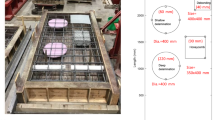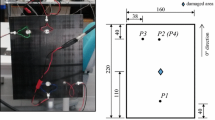Abstract
This paper discusses the use of a vibration-based technique for damage detection in metal and composite plate wrappings for pier foundation repairs. The SLSE (Scanning Laser-Strain Energy) method relies on full-field laser modal scanning and strain energy computation to establish damage locations within composite wrappings. Strain energy distribution relies on segmental derivation of detected deflection shapes; hence, large numbers of spatial data points are required. By providing high spatial data density, laser scanner complement nicely with the damage detection technique. Using an aluminum plate and a composite plate, results from a baseline scan test is presented in this paper to demonstrate the show the high potential of this technique for detecting damage in plates commonly used for structural repairs.








Similar content being viewed by others
Abbreviations
- P :
-
Loading intensity (FL−1)
- N x and N y :
-
Per unit length normal loads in the X and Y directions (FL−1)
- N xy :
-
Shear loading (FL−1)
- D :
-
Flexural rigidity (FL)
- h :
-
Plate thickness (L)
- E :
-
Young’s modulus (FL−2)
- ν :
-
Poisson’s ratio (–)
- λ ij :
-
Dimensionless parameter of mode indices i and j (–)
- γ :
-
Mass per unit area (ML−2)
- a :
-
Significant plate dimension (L)
- E 1 :
-
Fiber direction elastic modulus (FL−2)
- E 2 :
-
Transverse modulus (FL−2)
- G 12 :
-
In-plane shear modulus (FL−2)
- ν 12 and ν 21 :
-
In-plane Poisson’s ratios applied on the fiber and the transverse faces (–)
- ψ(x) :
-
Mode shape (–)
- f ij :
-
Vibration frequency (T−1)
- U :
-
Strain energy distribution (FL−2)
- ΔU :
-
Strain energy difference (FL−2)
References
Adams RD, Walton D, Flitcroft JE, Short D (1975) Vibration testing as a non-destructive testing tool for composite materials. Compos Reliab ASTM STP 580:159–175
Aidoo J, Harris KA, Petrou MF (2004) Fatigue behavior of carbon fiber reinforced polymer-strengthened reinforced concrete bridge girders. J Compos Constr 8(6):501–509
Ardelidis NP, Moropoulou A, Marioli Riga ZP (2003) The technology of composite patches and their structural reliability inspection using infrared imaging. Progr Aero Sci 39:317–328
Badawi M, Soudki K (2005) Concrete beams using carbon fiber-reinforced polymer laminates. J Compos Constr 9(2):195–201
Blevin RD (2001) Formulas for natural frequencies and mode shapes. Krieger Pub, New York
Bonfiglioli B, Pascale G, Martinet de Mingio S (2004) Dynamic testing of reinforced concrete beams damaged and repaired with fiber reinforced polymer sheets. J Mat Civ Eng 16(5):400–406
Boyajian DM, Davalos JF, Ray I (2005) Appraisal of the novel single contoured-cantilever beam. RILEM Mater Struct 38(275):11–16
Boyajian DM, Ray I, Davalos JF (2007) Freeze-thaw cycling under a calcium chloride environment: effects on CFRP strengthened concrete structures. Int J Mat Prod Tech 28(1/2):89–102
Buyukozturk O, Gunes O, Karaca E (2004) Progress on understanding debonding problems in reinforced concrete and steel members strengthening FRP composites. Constr Build Mat 18(1):9–19
Cawley P, Adams RD (1979) The location of defects in structures from measurements of natural frequencies. J Strain Anal 14(2):49–56
Chen SE, Venkatappa S, Petro SE, Ganga Rao HVS (2000) A novel damage detection technique using scanning laser vibrometry and a strain energy distribution method. Mat Eval 58(12):1389–1394
Cheng CT, Yang JC, Yeh YY, Chen SE (2003) Seismic performance of repaired hollow-bridge piers. Constr Build Mat 17(5):339–351
Choi S, Stubbs N (1997) Nondestructive damage algorithm for 2D plates. In: Proceedings of SPIE, smart systems for bridges, structures and highways (3043), San Diego, CA, pp 193–204
Cornwell P, Doebling SW, Farrar CR (1997) Application of the strain energy damage detection method to plate-like structures. In: Proceedings of 15th international modal analysis conference, Orlando, FL, pp 1312–1318
Davis AG, Dunn CS (1974) From theory to field experience with non-destructive vibration testing of piles. In: Proceedings of institute of civil engineers, London, vol 57(2), pp 571–593
Drain LE (1980) The laser Doppler technique. Wiley, New York
Gassman SL, Finno RJ (1999) Impulse response evaluation of foundations using multiple geophones. J Perf Const Fac 13(2):82–89
Hetlein B, Allen D (2006) Nondestructive testing of deep foundations. Wiley, New York
Hourani MS, Inyang HI (2006) Distribution deviation of large aggregates from uniformity in waste containment concrete. II: Experimental results and quality assurance. J Mat Civ Eng 18(1):73–80
Inyang HI, Hourani MS (2006) Distribution deviation of large aggregates from uniformity in waste containment concrete. I: Quantitative model formulation. J Mat Civ Eng 18(1):61–72
Jones R, Galea S (2002) Health monitoring of composite repairs and joints using optical fibers. Comp Struct 58:397–403
Kim JHJ, Lim YM, Won JP, Park HG, Lee KM (2007) Shear capacity and failure behavior of DFRCC repair RC beams at tensile region. Eng Struct 29:121–131
Lawrence TO, Boyajian DM (2006) Surface roughness, quasi-static fracture, and cyclic fatigue effects on GFRP- and CFRP-concrete bonded interfaces. J ASTM Int 3(1):1–16
Mirmiran A (1997) Behavior of concrete columns confined by fiber composites. J Struct Eng 123:583–590
Osegueda RA, Carreasco CJ, Meza R (1997) A modal strain energy distribution method to localize and quantify damage. In: Proceedings of 15th international modal analysis conference, Orlando, FL, pp 1298–1304
Pessiki S (2001) Axial behavior of reinforced concrete columns confined with FRP jackets. J Compos Const 5(4):237–245
Saadatmanesh H (1997) Repair of earthquake-damaged RC columns with FRP wraps. ACI Struct J 94:206–215
Sen R, Mullins G (2007) Application of FRP composites for underwater piles repair. Compos B 38:751–758
Wong CKW, Chiu WK, Rajic N, Galea SC (2006) Can stress waves be used for monitoring sub-surface defects in repaired structures? Compos Struct 76:199–208
Acknowledgments
The authors would like to acknowledge former colleagues, Mr. Samer Petro, Mr. Suhas Venkatappa and Dr. John Moody, for technical support throughout the scanning laser research. The financial support of the Constructed Facilities Center and Professor H.V.S. GangaRao at West Virginia University is also recognized.
Author information
Authors and Affiliations
Corresponding author
Rights and permissions
About this article
Cite this article
Chen, S.E., Boyajian, D.M. & Inyang, H.I. SLSE Damage Detection Technique for Foundation Strengthening Using Plates. Geotech Geol Eng 29, 237–248 (2011). https://doi.org/10.1007/s10706-010-9367-8
Received:
Accepted:
Published:
Issue Date:
DOI: https://doi.org/10.1007/s10706-010-9367-8




